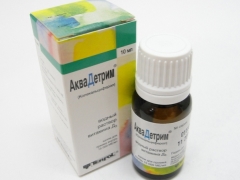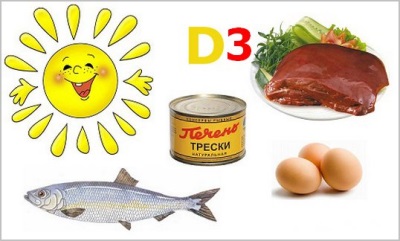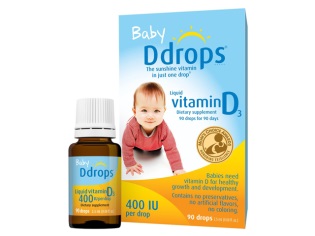Akvadetrim for children: instructions for use
One of the most important vitamins for young children is considered to be vitamin D. To prevent its shortage, many children are prescribed medications containing this vitamin. One of the most popular means can be called Akvadetrim. To know how to use this medicine in childhood correctly, you need to figure out when it is prescribed to children, how to take such droplets and when Aquadetrim is not needed.
Release form
Akvadetrim is available in liquid form - in drops. It is a clear, colorless liquid that may slightly opalescent. Akvadetrim drops have aniseed aroma. One package of the drug is represented by a 10-ml vial equipped with a dropper-shaped stopper.
Composition
The main ingredient in Aquadetrim is co-calciferol. So called vitamin D3, which in one ml of the drug contains 15 thousand IU. In 1 ml is placed 30 drops of Aquadetrim, that is, one drop of the medicine contains 500 IU vit. D.
Additional components of the drug are citric acid, sodium hydrogen phosphate and macrogol glyceryl ricinoleate, as well as benzyl alcohol and purified water. The sweet taste of Akvadetrimu provides sucrose added to the composition, and a special smell - anise flavoring.
Dr. Yevgeny Komarovsky will briefly tell all that parents of infants need to know about vitamin D to all parents of infants:
Operating principle
Akvadetrim is a medicine that affects the exchange of two important minerals in the children's body. One of them is calcium, and the second is phosphorus. The drug regulates their metabolism, with the result that the bones are mineralized and the baby’s skeleton develops properly.
In Aquadetrim, vitamin D is represented by the D3 form. This is a natural form that forms in the skin of people under the influence of the rays of the sun. If to compare with the form D2, then in colecalciferol there is an increased activity (approximately by 25%).
The drug is important for the absorption of phosphates and calcium salts in the intestine, the transport of these compounds throughout the body and their entry into the bone tissue. Also, Akvadetrim has an influence on their elimination from the body through the kidneys.
Without a sufficient amount of vitamin D, which helps to ensure the drug, the child may be disturbed not only bone calcification, but also myocardial function, muscle tone, blood clotting, parathyroid glands, immunity and nervous system. The lack of such a compound in food or due to a small stay in the sun becomes the cause of rickets.
Indications
In childhood, the main reason for prescribing Akvadetrim is the prevention of hypovitaminosis D and, as a result of this problem, rickets. Also, the drug is prescribed for therapeutic purposes with diagnosed vitamin D deficiency and with rickets, if it has already developed in a baby. In addition, the use of Aquadetrim is indicated for the prevention or treatment of such diseases:
- Osteomalacia.
- Hypoparathyroidism.
- Hypocalcemic tetany.
- Pseudohypoparathyroidism and other rickets-like diseases.
At what age is it allowed to take?
Instructions for use Akvadetrima indicates that such a drug is given to children who have turned 4 weeks. It means that the drug is contraindicated in the neonatal period. However, to give Akvadetrim monthly child without consulting a doctor should not be. This is due to both possible side effects and the risk of overdose. For this reason, both children under one year old and a child older, for example, at the age of 2 years or 5 years, should only be prescribed by the doctor.
For the benefits of vitamin D for babies, see the video:
Contraindications
Instructions for use prohibits giving Akvadetrim in such cases:
- If the sensitivity to the components of the drug in the baby is increased.
- If a child has hypervitaminosis D.
- If oxalate calcium stones are found in the kidneys of the child.
- If the blood test showed excess calcium (hypercalcemia).
- If calcium is detected in the urine (analysis showed hypercalciuria).
- If the baby has kidney disease, as well as kidney failure.
- If active pulmonary tuberculosis is diagnosed.
- If a patient has sarcoidosis.
The drug is used very carefully, if the infant has a front fontanelle of small size (this is evidence of a predisposition to its earlier closure).
Side effects
Sometimes the child's body may react to Akvadetrim:
- Loss of appetite
- Nausea
- Muscle pain.
- Vomiting.
- Polyuria.
- Weakness
- Depressive state.
- Joint pain.
- Dry mouth.
- Increased body temperature.
- Headaches.
- Changes in urine tests (elevated levels of protein, hyaline cylinders, leukocytes) and blood (elevated calcium levels).
In some children, sleep is disturbed (the child does not sleep after the medicine), constipation appears, and body weight decreases. In addition, allergies, such as skin rashes, can occur on Aquadetrim.
What if there are such symptoms? First of all, cancel the medication and contact your doctor. The doctor will examine the child, prescribe the necessary treatment, and advise that the food given to the baby contain less calcium.
Instructions for use
How to give Akvadetrim
The medicine is given to the child to drink by dropping the required amount of the drug in a spoonful of water or other liquid (can be mixed with baby food). This is best done in the first half of the day after meals.
Dosage
- For prophylaxis, Akvadetrim is prescribed to children older than 1 month, 1-2 drops per day, which corresponds to 500-1000 IU of vitamin D. Such a dosage is sufficient for babies who walk enough in the open air and receive vitamins from food.
- In the summer, the daily dose of Aquadetrim may be reduced. until one drop or drug is canceled.
- Babies who were born ahead of time, as well as for children born from multiple pregnancies, the prophylactic dose will be 2-3 drops of Akvadetrima (this is 1000-1500 IU). The same dose is recommended for babies if their living conditions are unfavorable.
- For the treatment of rickets, the dosage of Akvadetrim is determined individually, considering the course and severity of the disease. The therapeutic dose of the drug is from 4 to 10 drops per day (from 2 to 5 thousand IU). Begin treatment with a dose of 2000 IU, and then, if the child tolerates the drug well, the number of drops gradually increases over several days.
- How many drops of Akvadetrima to give in the treatment of hereditary diseases, which are called rickets-like, should be determined by the doctor.
A video review of the drug Akvadetrim can be viewed here:
Duration of use
The drug for rachitis is prescribed for 4-6 weeks under the control of tests and the general condition of the child. If the therapy needs to be continued, Aqvadetrim begins to be given again after a week break. Treatment is completed when a pronounced therapeutic effect is obtained, after which they switch to the prophylactic dosage recommended for all children (500-1000 IU).
But to what age should Aqvadetrim be given as a preventive measure to healthy babies? Most pediatricians advise to continue taking such a tool for up to 2-3 years, interrupting the application only for the summer period. When testimony babies continue to give droplets and in the summer and over the age of 2 years.
Overdose
The following dosage may occur to the overdose of Aquadetrim:
- Decreased appetite.
- Attack of vomiting.
- Restless behavior.
- Increased thirst.
- Nausea.
- Stomach ache.
- Diarrhea or, conversely, constipation.
- Excretion of urine in large quantities.
- Pain in the joints or muscles.
- Headaches.
- Stupor and other mental disorders.
- Weight loss.
On an overdose of vitamin D in a children's body, Dr. Komarovsky said a few words:
With an excessively high dose, for example, if the child drank the floor of the tube of Akvadetrim, kidney function is disturbed, blood pressure rises, baby is drowsy. In such situation there is a risk of eye problems, affecting both the iris or cornea, and the optic nerve.
Also, excessive intake of Aquadetrim can cause stones in the organs of the excretory system, the deposition of calcium in the walls of blood vessels, skin and internal organs. In rare cases, the drug provokes the development of cholestatic jaundice.
In a situation where a child accidentally drank a lot of Akvadetrim, it is important to immediately cancel the medication and give the baby plenty of fluids. Since it is dangerous to health, in many cases a child with an overdose of Akvadetrim is hospitalized.
Interaction with other drugs
- Vitamin D from Akvadetrima will be worse absorbed if the child simultaneously takes Kolestiramin, rifampicin or drugs against epilepsy.
- If the baby is given thiazide diuretics and Akvadetrim at the same time, it can increase the level of calcium in the blood.
- When prescribing Akvadetrim to a child who is given glycosides, the toxic effect of such heart remedies will increase, which threatens with arrhythmias.
- The simultaneous appointment of Akvadetrim and calcium preparations with a high dosage of this mineral is not recommended.
Terms of sale
To buy Akvadetrim in a pharmacy, presenting a prescription is not required. The average price of one pack of such drops is 180-200 rubles.
Storage conditions and shelf life
To prevent the drug from losing its properties, it should be kept away from light, and the air temperature at the storage location should not exceed + 25 ° C. To Akvadetrim, as well as to other medicines, there should not be an access at kids. The shelf life of the drug is 3 years, but after opening it is recommended to use the contents within 4-6 months.

Reviews
About akvadetrim and its use in children are mostly positive reviews. Many parents believe that this medicine is very important for the normal development of babies, especially in winter. Confirmation of the effectiveness of the drug for them is the absence of symptoms of rickets in children taking prophylactic doses of Akvadetrima.
However, there are negative opinions, for example, some parents do not like the dispenser in the package, someone considers the oil solution to be more effective, and someone has long enough lists of contraindications and side effects.
However, children tolerate Aquadretri mostly well. Allergic reactions to such medication are rare, and if the doses prescribed by the doctor are observed, Aquadetrim does not cause other side effects.
Analogs
Instead of the drug Akvadetrim, you can use an aqueous solution of Vitamin D3 from other manufacturers. This is an equivalent substitute for Aquadetrim, since the drug is represented by the same form of vitamin dissolved in water.
Also, a child with rickets or for the prevention of this disease can be replaced Akvadetrim with an oil solution, for example, with medicine Viganol. A good option would be Finnish vitamins, for example, Sana-sol D3-tipat in coconut oil (this analogue is allowed from 2 weeks of age), Minisun Drops D3 or drug Drops d3 from DeviSol.
Akvadetrim or Vigantol - which is better?
The main difference between such preparations containing vitamin D3 is represented by the base of the solution - in Aquadetrim it is purified water, and in Vigentol it is medium chain triglycerides (and therefore it is an oily solution). Both drugs are released in bottles of 10 ml, and one drop of Vigentola and Akvadetrim gives the child 500 international units of coralciferol.
Pediatricians write out any of these drugs for rickets, as well as for disorders of calcium metabolism. AND Akvadetrimand Viganol prescribed to prevent hypovitaminosis D children of the first 2-3 years of life. Both drugs are approved for use from 4 weeks of age. They have the same side effects, one way to use (the droplets are mixed with liquid in a spoon and given to the child) and there is almost no difference in price.
The differences of drugs are their peculiarities:
- Vigantol is a thicker fluid. which has a yellowish tint and no smell, but Akvadetrim more liquid, colorless, smells good and tastes sweet.
- The composition of Vigantola is simpler, because besides vitamin D and triglycerides, there are no longer any chemical additives. At the same time in Preservatives, sucrose and flavoring agents are present in akvadetrime, to which children can react with allergies.
- Vigantol is not recommended for problems with the biliary tract, intestines and liver.. The remaining contraindications for both drugs are identical.
- Akvadetrim give children daily, and in the Viganthol manual there is a recommendation give droplets 5 days in a row, and then take a break for two days, then continue the application in the same mode (give five days and not give two days).
- To buy Vigantola in a pharmacy need a prescription, and Akvadetrim is an over-the-counter medicine.
- Vigantol has a longer shelf life.and (it is 5 years) and temperature storage conditions are limited to + 15 + 25 ° С. At the same time, both drugs after opening the bottle should be used up to 6 months.
Determine which source of vitamin D is best for a particular child, stands with the pediatrician, who observes the baby from birth. The doctor will evaluate the infant's nutrition, living conditions, skin color, season and other factors, after which he will recommend the most appropriate remedy and its dosage.



















